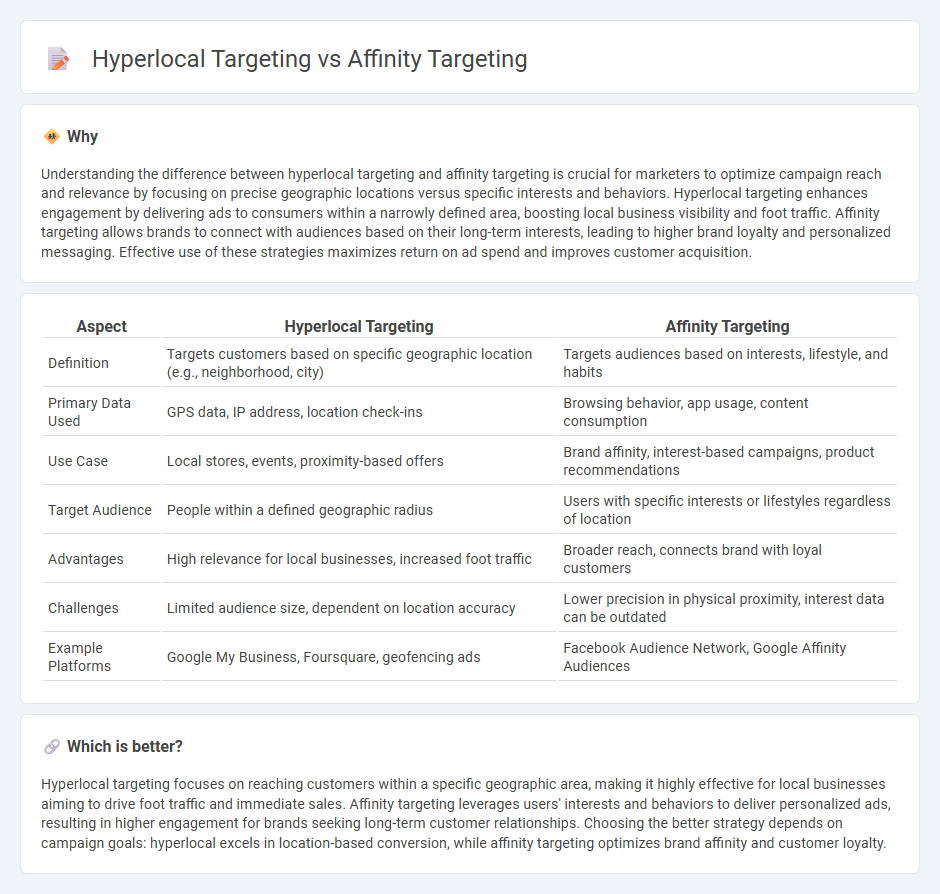
Hyperlocal targeting zeroes in on consumers within a specific geographic area, allowing marketers to deliver personalized content and promotions based on precise location data. Affinity targeting focuses on audiences' interests, behaviors, and lifestyle patterns to align marketing efforts with consumer preferences across broader regions. Discover how leveraging hyperlocal and affinity targeting can elevate your marketing strategy and boost conversion rates.
Why it is important
Understanding the difference between hyperlocal targeting and affinity targeting is crucial for marketers to optimize campaign reach and relevance by focusing on precise geographic locations versus specific interests and behaviors. Hyperlocal targeting enhances engagement by delivering ads to consumers within a narrowly defined area, boosting local business visibility and foot traffic. Affinity targeting allows brands to connect with audiences based on their long-term interests, leading to higher brand loyalty and personalized messaging. Effective use of these strategies maximizes return on ad spend and improves customer acquisition.
Comparison Table
| Aspect | Hyperlocal Targeting | Affinity Targeting |
|---|---|---|
| Definition | Targets customers based on specific geographic location (e.g., neighborhood, city) | Targets audiences based on interests, lifestyle, and habits |
| Primary Data Used | GPS data, IP address, location check-ins | Browsing behavior, app usage, content consumption |
| Use Case | Local stores, events, proximity-based offers | Brand affinity, interest-based campaigns, product recommendations |
| Target Audience | People within a defined geographic radius | Users with specific interests or lifestyles regardless of location |
| Advantages | High relevance for local businesses, increased foot traffic | Broader reach, connects brand with loyal customers |
| Challenges | Limited audience size, dependent on location accuracy | Lower precision in physical proximity, interest data can be outdated |
| Example Platforms | Google My Business, Foursquare, geofencing ads | Facebook Audience Network, Google Affinity Audiences |
Which is better?
Hyperlocal targeting focuses on reaching customers within a specific geographic area, making it highly effective for local businesses aiming to drive foot traffic and immediate sales. Affinity targeting leverages users' interests and behaviors to deliver personalized ads, resulting in higher engagement for brands seeking long-term customer relationships. Choosing the better strategy depends on campaign goals: hyperlocal excels in location-based conversion, while affinity targeting optimizes brand affinity and customer loyalty.
Connection
Hyperlocal targeting leverages precise geographic data to reach consumers within specific neighborhoods or small communities, creating highly relevant marketing messages. Affinity targeting uses consumer interests and lifestyle preferences to identify audiences more likely to engage with certain products or services. The connection lies in combining location-specific insights from hyperlocal targeting with the interest-based data of affinity targeting, enabling brands to deliver personalized, contextually meaningful campaigns that drive higher engagement and conversion rates.
Key Terms
Audience Segmentation
Affinity targeting segments audiences based on long-term interests, lifestyle, and habits, enabling advertisers to connect with consumers who demonstrate a consistent passion for specific topics or brands. Hyperlocal targeting hones in on users within narrowly defined geographic areas, capitalizing on location data to deliver highly relevant and time-sensitive messages tailored to local preferences and events. Explore the strategic advantages of both approaches to optimize your audience segmentation and drive more effective marketing campaigns.
Geographic Location
Affinity targeting focuses on grouping audiences based on interests and lifestyle, often transcending geographic boundaries, while hyperlocal targeting zeroes in on a very specific geographic location, such as a neighborhood or a few blocks. Hyperlocal targeting leverages detailed location data to deliver highly relevant ads to users in proximity, enhancing local business engagement and foot traffic. Explore more to understand how these targeted strategies can optimize your marketing campaigns.
Consumer Interests
Affinity targeting analyzes consumer interests, behaviors, and lifestyles to deliver relevant ads based on established preferences, enhancing engagement by reaching audiences with shared values. Hyperlocal targeting zeroes in on precise geographic locations, focusing marketing efforts on consumers within narrow physical areas to drive local visits and sales effectively. Explore the nuances of affinity and hyperlocal targeting to optimize your marketing strategies for better consumer connection and conversion.
Source and External Links
Ultimate Guide to Understanding In-Market vs. Affinity Audiences - Affinity targeting involves reaching groups of people who share common interests, hobbies, or lifestyles, based on their long-term behaviors and interests rather than recent purchasing intent.
Affinity audiences targeting - Display & Video 360 Help - Affinity audiences are used by advertisers to raise awareness by targeting users with strong, ongoing interests in specific areas, identified from their online activities across Google and third-party sites.
What Are Affinity Audiences, and How Do You Target Them? - Affinity targeting enables marketers to show ads to users grouped by shared interests or behaviors discovered through analysis of long-term web browsing habits, search queries, and content interactions.
 dowidth.com
dowidth.com